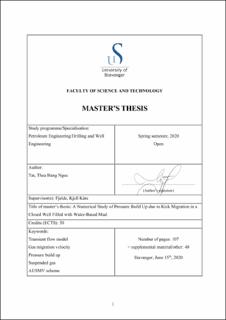| dc.description.abstract | There has been considerable and diverging discussion in the academic literature regarding the real gas kick velocity. This thesis contributes to improving and sharing the knowledge about the real gas kick velocity. It is demonstrated that estimating gas kick migration velocities using pressure build up slopes is an unreliable method. In Non-Newtonian drilling fluids, some of the gas volumes may be suspended in the mud, which can explain why there has been reported large discrepancies on what the gas kick migration velocity can be. This is one potential explanation, but future research should investigate this topic even further.
A transient flow model based on the drift flux model supplemented with a gas slip relation was used. The transient flow model was solved by an explicit numerical scheme (AUSMV) in MATLAB. The slope limiter concept was applied, and numerical diffusion was reduced to obtain optimal results. In the existing numerical scheme, the old model, a fixed gas slip model was implemented, i.e. the slug model. Hence, the gas migration velocity was a constant value. As for the new model, different flow patterns were included, i.e. suspended gas, bubble flow, slug flow, and the transition to one-phase gas. Appropriate transition intervals were linearly interpolated. Pressure build up for kick migration in a closed well was studied to observe how it varied from the impact of having a gas slip model which varied depending on what kind of flow pattern that was present at different locations in the well. A closed well of constant geometry was considered in order to study the pressure evolution. A sensitivity analysis was performed by varying kick sizes, suspension limits, and changing the transition intervals between the flow patterns. The analysis helped identifying the variables that were of major influence.
Simulation results showed that the slope of the pressure build up was influenced by suspension effects; the slope was reduced for increasing suspension limits. For cases where substantial suspension effects were considered, the pressures reached stable values quite early. The gas volume fraction depth profiles revealed that the gas kick was fully suspended in the well. In cases where the kicks were still able to migrate, the gas kick bulks migrated at the same velocity as long as they were in the same flow regime despite the different suspension limits that affected the pressure build up slopes differently. It seems impossible to determine a unique gas velocity from different pressure build up slopes. Nevertheless, they could be used to predict flow pattern transitions as abrupt changes in the slope were observed when flow pattern transitions occurred. | en_US |
